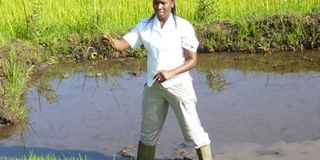Brief news on farming and agribusiness in the country

An expert in rice cultivation explains a point on the crop's farming in a paddy, in this past photo. Kenya is among three countries in the continent set to benefit from a project seeking to triple rice productivity in the next three years. FILE PHOTO | NMG
What you need to know:
- About 80 per cent of Kenya’s rice is imported, despite the country having a great potential to produce the crop.
- The national rice production is currently at 150,000 metric tonnes against an annual consumption of 650,000 metric tonnes.
- Currently, there is plenty of reusing the same low-yielding and often disease-ridden crop varieties making it impossible for smallholder farmers to improve their yields.
- Dr Joseph De Vries, the head of the Seed Systems Group, noted that 700 new, improved varieties have been developed in the past years, making them an invaluable asset in fighting hunger and jump-starting rural economies across Africa.
New project targets 400,000MT per year rice production
Kenya is among three countries in the continent set to benefit from a project seeking to triple rice productivity in the next three years.
The initiative supported by the International Fund for Agricultural Development (Ifad), the Africa Rice Centre (AfricaRice) and the Africa Harvest Biotech Foundation International (Africa Harvest), is working with the governments of Kenya, Uganda and Madagascar to innovatively enhance the performance of the local rice value chains.
Agriculture Cabinet Secretary Mwangi Kiunjuri said they aim to boost output to 400,000 metric tonnes by 2022, under the Big Four Agenda.
“We count on the expertise of AfricaRice, Africa Harvest and our scientists to assist in production and reduction of postharvest losses,” said the CS.
About 80 per cent of Kenya’s rice is imported, despite the country having a great potential to produce the crop.
The national rice production is currently at 150,000 metric tonnes against an annual consumption of 650,000 metric tonnes.
The three-year project titled ‘Strengthening the rice sector in East Africa for improved productivity and competitiveness of domestic rice’ will adapt appropriate technologies and innovations to address emerging value chain constraints.
It will also strengthen functional linkages among key rice stakeholders using “multi-stakeholder innovation platforms and improve capacity of farmers and other rice value chain actors, including input dealers, millers and marketers”.
About 18,000 stakeholders, including rice farmers, seed producers, extension service providers, processors and national research staff will benefit in the three countries.
At least 40 per cent of this target group is expected to be women, and at least 20 per cent youth aged 15-35 years.
-Anita Checpkoech
****
Study: Quality seeds guarantee higher smallholder incomes
A new report by Nairobi-based Seed Systems Group (SSG) shows that 15 African countries with average child malnutrition rates of 38 per cent can significantly better their food security and nutrition by improving their seed industries.
The report reveals that if one-third of farmers in the countries are able to obtain improved seeds, they could generate an additional 25 million metric tonnes of food worth Sh414 billion.
The countries that include Angola, Benin, Burundi, Cameroon, Chad, Congo and Togo host 315 million people.
Currently, there is plenty of reusing the same low-yielding and often disease-ridden crop varieties making it impossible for smallholder farmers to improve their yields.
Dr Namanga Ngongi, the SSG board chairperson, said improved seeds equal improved lives.
“Countries that were bypassed during Africa’s first 10 years of local seed industry growth can learn from their neighbours. They can leapfrog development of their seed systems to bring their farmers quality seeds that yield more and stand up to climate change,” said Dr Ngongi.
Dr Joseph De Vries, the head of the Seed Systems Group, noted that 700 new, improved varieties have been developed in the past years, making them an invaluable asset in fighting hunger and jump-starting rural economies across Africa.
“We now have the seeds, and we know how to deliver them. The farmers have consistently shown they will buy it. Conditions are ripe. We have to act on this,” said Dr DeVries.
He added that more than 80 per cent of African seed start-ups launched since 2007 are now supplying smallholder farmers with the latest crop varieties.
-Brian Okinda




